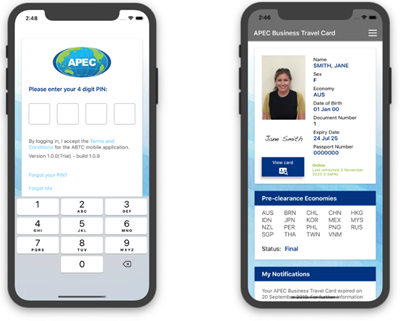Last page update:
About
 The
APEC Business Mobility Group launched the virtual APEC Business Travel Card (ABTC) during APEC Leader’s Week in
November 2020.
The
APEC Business Mobility Group launched the virtual APEC Business Travel Card (ABTC) during APEC Leader’s Week in
November 2020.
The virtual ABTC is an innovative new method for travelling with the ABTC. It brings the existing scheme into the digital era, providing the much-valued service through cardholders’ smart devices. The virtual ABTC is a more
secure, efficient, convenient and user-friendly service and importantly, it provides real-time updates, so that a cardholder can immediately benefit from using their virtual ABTC.
Travelling on the virtual ABTC allows for the same streamlined and VIP service existing cardholders have come to enjoy, but will provide an alternative method for producing and presenting their card when entering and exiting an APEC economy.

Each Economy will determine its own timeline to transition its cardholders to the virtual ABTC; however, from 1 March 2021 economies can expect to see the first travellers using the virtual ABTC—with Australia being the first APEC economy to transition all their cardholders over to the virtual ABTC. The Business Mobility Group looks forward to seeing other economies transition to the virtual ABTC shortly thereafter.
The virtual ABTC employs security features to provide economies greater confidence to determine that a digital ABTC and cardholder are genuine. These features include:
- Secure sign on – An approved ABTC applicant will be sent an email with a unique token (an individual application number) for their virtual ABTC and a link to download and log onto the virtual ABTC app.
- User authentication – Users are required to ensure their user credentials are authenticated and verified when accessing the virtual ABTC app. Only approved ABTC cardholders who have been granted access to the virtual ABTC can log on—please refer below to the documents below for the step-by-step process.
- Screenshots – On Android devices, users are prevented from taking screenshots of the virtual ABTC; and on iOS devices, users who attempt to take a screenshot of the virtual ABTC will be presented with a message reminding them that airport officials will not accept a screenshot of the virtual ABTC.
- Watermarks – The card screen of the virtual ABTC will have APEC and other discrete security watermark features, making it difficult to fraudulently replicate. The holographic overlay and card background pattern change colour and visibility in real-time in correlation with movement of the smart device, allowing airport officials to quickly confirm that they have been presented with the official virtual ABTC rather than a screenshot or video capture.
These additional security features for the virtual ABTC hinder fraudulent replication and misuse, and protect cardholders and their personal details.
For more information on the virtual ABTC take a look at our videos and information guides below.
Introduction to the Virtual APEC Business Travel Card for Cardholders
Introduction to the Virtual APEC Business Travel Card for Port Officials
Virtual Cardholder Travel Advice
Latest Updates
- Russia
Russia advised that they are unable to accept virtual ABTCs at this time. However, Russia announced a temporary travel scheme for eligible virtual ABTC card holders, commencing on Monday, 10 April 2023.
The temporary travel scheme facilitates a special permit granting a multiple entry and stay visa to Russia. The special permit will be valid for five years from the date of issue and will be issued free of charge in any Russian Federation diplomatic mission or consular office.
To be eligible for the special permit, ABTC holders must:
- have received pre-clearance from Russia and
- not have a physical ABTC.
Russia continues to accept physical ABTCs from all participating APEC economies.
In order to apply for a special permit for multiple trips to Russia, applicants are required to submit a completed visa application form, photo, passport and a personal statement to any diplomatic mission or consular office of Russia abroad.
Taking into account the formal financial regulations in force in diplomatic missions or consular offices of the Russia abroad, the personal statement to the head of a diplomatic mission or consular office of Russia should request to exempt the applicant, on the basis of the principle of reciprocity applied within the APEC forum when processing documents for business and official trips, from charging any fees for issuing the special permit multiple entry visa the same as when using a physical ABTC with a limitation of the total period of stay in Russia of 90 days from each period of 180 days .
An approved permit will be printed on a visa sticker form and pasted into the applicant’s passport.
Virtual ABTC holders may also wish to confirm the status of their pre-clearance to Russia using the ABTC pre-clearance status tracker.

